The Best Exercise Mats for Working Out, According to Fitness Experts

Our editors independently select the products we recommend. We may earn a commission on items bought through our links.
Whether you’re mastering downward dog, pumping iron, or breaking a sweat with some high-intensity interval training, a quality exercise mat can make all the difference in a workout. More than a “nice-to-have,” a reliable mat keeps you safe on your feet — or comfortable on your backside — so you can get down to business and perform like a pro, without distraction or mishap.
Today's Top Deals
Exercise mats come in a variety of materials, sizes, thicknesses, and textures; some feature sweat-wicking technologies or accessories to accommodate every gym-goer or yogi. Expect to shell out anywhere from $20 to $150 for a quality mat, though even a $30 mat can go a long way in terms of safety and performance, as long as it provides what you need, says Marc Coronel, BA, a TRX Senior Master Course Instructor and a Functional Training Coach at Energia Fitness in Las Vegas.
In a quest to find the best exercise mats for its readers, SPY tapped fitness experts for advice on selecting the right ones for any sweat sesh. Read on to hear what they had to say and shop SPY’s curated picks.
What the Experts Say
SPY dug into researching what makes an exercise mat “great” by speaking to fitness industry experts: Colonel and Nicholas Duran, an E-RYT 200 certified yoga instructor, NASM-certified personal trainer, and fitness and movement pro at Equinox and Heroic Performance Fitness in Los Angeles.
According to them, each individual needs something a little bit different from their mat, depending on their workout demands. You might need an extra durable, non-slip surface to prevent face plants in front of your HIIT class, a firm platform to stabilize a squat, or a moisture-wicking, antimicrobial option to keep sweat and funk at bay in hot yoga.
Whatever your workout demands, SPY’s experts say to consider the following factors when buying your exercise mat:
Type of Workout: To choose the right mat for your specific needs, consider the type of workout you’ll be doing most often. Some workouts require different support, cushioning, traction, and stability levels. If you’re doing high-impact exercises, like plyometrics or cardio, you’ll need a mat with more cushioning to protect your joints. For yoga or pilates, you might prioritize a mat with more grip and stability for holding poses. And if you’re traveling to a studio for your sweat session, you’ll want something lightweight and portable.
Material: The materials that make up your exercise mat might affect its durability, comfort, ease of cleaning, and eco-friendliness. Exercise mats are usually made from PVC (polyvinyl chloride), natural rubber, TPE (thermoplastic elastomer), vinyl, foam, cork, and even a combination of materials. PVC mats are durable and affordable but aren’t as eco-friendly when it’s time to toss yours. Natural rubber mats offer excellent, slip-free grip and are biodegradable, but can be a bit pricey. TPE mats are recyclable and have good “rubber-like” grip and cushioning, while cork mats have naturally antimicrobial properties but may not offer as much cushioning or grip (until they’re wet).
Grip: The last thing you’ll want during your plank-a-day or burpee challenge is a slippery mat. A mat with good grip ensures that you can maintain proper form and stability during workouts while reducing the risk of injury. Look for mats with textured or non-slip surfaces that provide traction, especially when performing hot yoga or intense workouts that will have you sweating more.
If you sweat a lot, a moisture-wicking (open-cell) mat is great for its grippy surface that absorbs perspiration — but be advised that i’tll need a thorough, regular cleaning to prevent bacteria and odor buildup. Closed-cell mats are often marketed as “antimicrobial” because they repel moisture and prevent it from seeping into their surfaces; this means they’re easier to clean. They can be grippy and textured or smoother to allow for gliding motions, depending on your workout.
As self-professed heavy sweaters, both Coronel and Duran prefer an open-cell mat that provides moisture-wicking grip and stability for yoga, HIIT, and more. “I sweat my head off,” says Coronel. “I like it when [mats] absorb sweat more than they repel it…but they’re also incredibly hard to clean. Ultimately, you just have to find what you like.”
Another thing to think about is the type of surface on which you’ll use the mat. If exercising on hardwood floors, consider a mat that’s cushioned so it doesn’t hurt to kneel; if the surface is carpet or grass, a thinner, non-slip mat with a bit of weight is more ideal for stability.
Thickness: Exercise mats come in thicknesses ranging from 3 millimeters to 25 millimeters, depending on their construction; this thickness affects mat’s cushioning, support, and stability. Thicker mats offer more cushioning and support for sensitive joints, knees, wrists, and elbows but are often less stable for balancing poses or strength-training and lifting. Thinner mats offer more stability but less comfortable cushioning for certain exercises. Selecting the right thickness depends on your personal preference and the type of exercises you’ll be doing.
Size: For most workouts, a mat should be large enough to lie down on — a mat that’s too small may lead to discomfort, especially during exercises that require a wide range of motion, whether it’s lunges, stretches, or burpees. Consider the dimensions of the area where you’ll be using the mat and choose one that can both accommodate your body and comfortably fit within your space.
From a standard mat size (roughly 68 to 72 inches long and 24 inches wide) to larger mats, there are spacious options to facilitate any body size — even extra-large options to equip the entire floor of a home gym. “I like a slightly longer and wider mat [because] I’m six-foot-two and I don’t want to feel like I’m falling off my mat,” says Coronel.
Keep in mind that your mat’s materials, thickness, and size will determine how heavy and portable it is, says Duran. Ultimately, SPY’s experts say that the right mat depends on your preferences for comfort, support, and stability, plus its level of sustainability, maintenance, portability, and longevity.
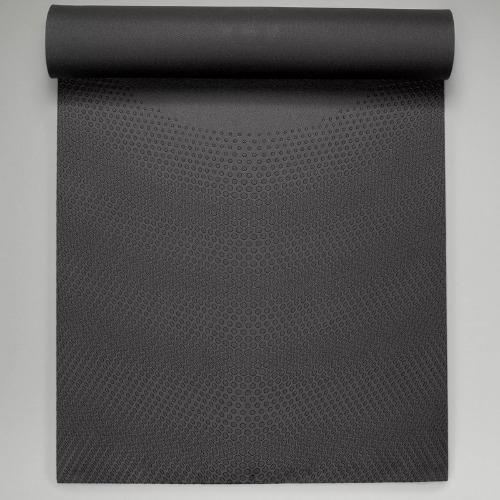
BEST OVERALL
Lululemon's The Workout Mat
Buy Now
This multi-purpose exercise mat tops our list with its grippy, textured surface, durable construction, and easy-to-clean, portable design that works well with a variety of workouts and indoor-outdoor environments. Whether you’re strength training with weights or practicing some restorative yoga, The Workout Mat can endure a whole host of rough activities — shoes on or off.
It has a raised-dimple texture for extra grip during barefoot or dynamic movements and a closed-cell design that makes it easy to clean up after training. And the 6-millimeter cushion (made from recyclable TPE) provides ample support underfoot without compromising stability. Made slightly wider than most standard-size yoga mats, this 26 x 71-inch mat rolls tightly and weighs under 5 pounds for easy storage and portability.
Another fun fact for the eco-friendly: This sleek mat’s top and bottom are made using salvaged, recycled PVB (Polyvinyl Butyral) — a resin used in windshields and other safety glass — saving the environment from waste while making a long-lasting mat for dozens of workouts to come. Just shy of $100, the versatile Workout Mat is one of the best investments to make in exercise gear.
Also Consider: The sustainably-made alo Warrior Mat is a fine — albeit pricier — alternative, with durable construction, a grippy surface, and a supportive 5-millimeter cushion that provides plenty of protection for joints and stability of form.
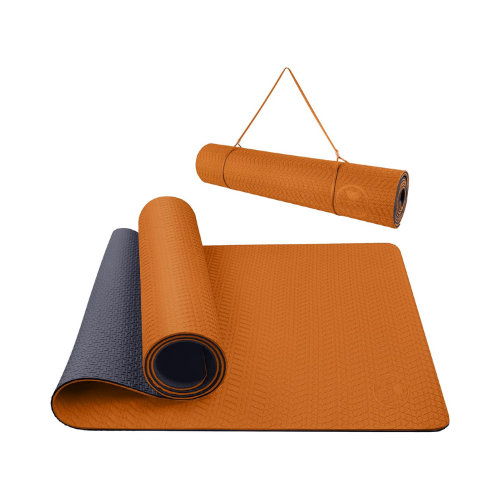
BEST BUDGET
IUGA Non-Slip Anti-Tear Yoga Mat
Buy Now On Amazon
If you’re exercising on a budget, this IUGA’s Yoga Mat is an affordable, yet durable option that can go well beyond the yoga studio without breaking the bank. Great for beginners and experienced exercisers alike, this eco-friendly TPE mat has an impressively grippy, double-sided surface that works well for a variety of intense workouts, whether you’re performing plyos or working on your tree pose.
Constructed with an open-cell design, the IUGA mat absorbs moisture efficiently, maintaining its grippy texture throughout the sweatiest of sessions. Six millimeters of dense cushion provides firm stability and gentle shock absorption for jumps, as well as comfort for resting wrists, elbows, and sensitive joints. For such quality, sustainability, and comfort, it’s also shockingly lightweight at just two pounds.
Complete with a free carrying strap, the IUGA Yoga Mat is a great value for under $40.
Also consider: When you just need something to “git’er done,” this even more affordable Amazon Basics Exercise Mat is a reliable, thrifty option for an extra cushioned, non-slip workout.
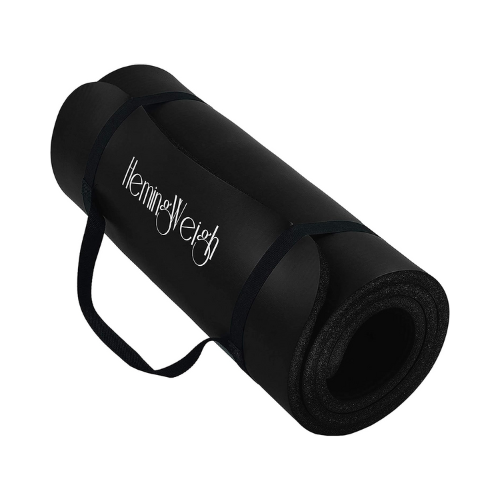
BEST THICK
HemingWeigh
Buy Now On Amazon
When you need an extra plush mat to soften landings or protect sensitive joints, HemingWeigh is your best bet. Not only is this 25-millimeter (1-inch), rubber mat comfortable and supportive, but both sides are non-slip so you feel extra secure. Its closed-cell, moisture-resistant surface is easy to clean and maintain.
The HemingWeight’s double-sided, latex-free rubber construction is rip-resistant, unlike wannabe knock-offs. While it’s not as stable for challenging yoga as others on this list, it is a versatile option for beginner restorative (yen) yoga and a ton of other workouts where extra padding is helpful.
Considering its high-quality, durable construction, this thick, standard-sized mat is surprisingly lightweight at just over 3 pounds. It comes with a carrying strap for travel or storage and retails for $70.
Also consider: For an even thicker option that’s a touch wider, this ProsourceFit’s Tri-Fold Folding Thick Exercise Mat has 1.5 inches of water-resistant cushion that folds and stores neatly under a couch or bed.

BEST NON-SLIP
Gaiam Dry-Grip Yoga Mat
Buy Now On Amazon
Buy NOW at gaiam
An exercise mat with great grip and traction is crucial to getting the most out of your workout, especially if you sweat a lot, say Coronel and Duran. Gaiam’s Dry-Grip Yoga Mat keeps sweat safely under control for those hot yoga or swampy summer gym sessions thanks to open-cell construction and a non-slip top coating.
When it comes to performance, Coronel likes and recommends Gaiam’s mats for their reliability and versatility. This mat, along with its wider, longer version, is no exception. Designed for yoga, but applicable to much more, this 5-millimeter mat is a firm and stable foundation for perfecting poses or hammering out some HIIT.
Durable, and rubber- and latex-free, this high-quality, PVC mat is made to last, rivaling much more expensive alternatives at $70.
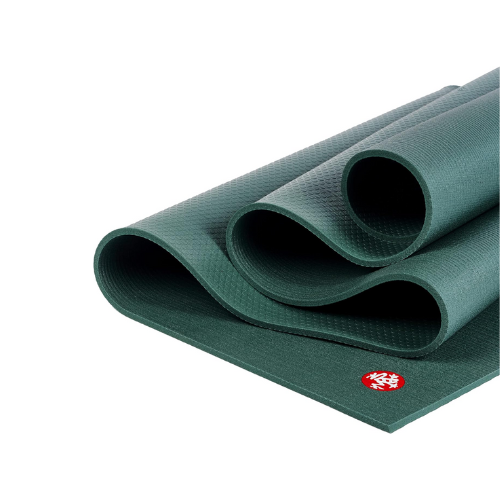
BEST FOR YOGA
Manduka Pro Yoga Mat
Buy Now On Amazon
Buy now at rei
Buy Now at manduka
A fan-favorite mat for its quality, weight, and grip, Manduka’s Pro Yoga Mat is beloved by seasoned yogis, including Duran, and fitness instructors, like Coronel. Sustainably made with OEKO-TEX certified-safe PVC and closed-cell, this high-quality, antimicrobial mat is geared toward a balanced grip and slide that keeps your practice safe, comfortable, and hygienic.
With its 6-millimeter ultra-dense cushion, Duran loves that it’s easy on joints and knees, yet stable enough for challenging poses. And though it’s closed cell, the beauty of this mat is that it becomes grippier the more it’s used (i.e. “seasoned”). In the meantime, keep a towel handy if your session gets extra sweaty, says Duran.
At 71 by 26 inches, this spacious mat provides a ton of room for mobility. There’s an even larger mat size, too, for those who need more space. “I like how it actually accommodates someone [taller],” says Coronel. “I first saw it when I was sitting next to a football player in a yoga class and I was like, ‘Dude, your mat’s huge!’”
The Maduka Pro is one of the priciest options on our list (at $138), but SPY considers this an exceptionally worthy investment considering its longevity and lifetime guarantee.
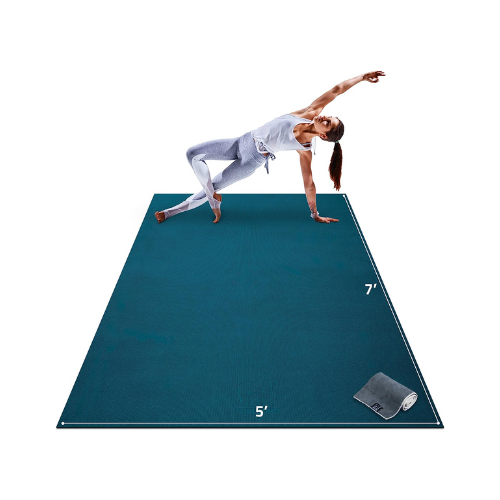
BEST LARGE
Gorilla Mats Premium Large Yoga Mat
Buy Now On Amazon
If you want plenty of space for your workouts, Gorilla Mats’ Premium Large Yoga Mat is an extra-large option that spans 7 by 5 feet. With enough room to fit more than one workout partner, this mat is a great option for a home gym.
This big mat features 8 millimeters of dense, grippy cushion that’s comfortable yet durable enough for barefoot yoga or pilates, HIIT, or strength-training sessions. Also, its closed-cell construction makes its monstrous surface more manageable to clean.
Available in even more sizes to suit your needs, you can drop anywhere from $129 to $369 for a Gorilla Mat, with this one retailing for $190.
Also consider: For something a little less massive, CAP’s Barbell Foam Mat gives you over 7 by 3 feet to work with when performing everything from lifting to HIIT. If you need a portable option, Gaiam’s Athletic Yoga Series dynMat Xtra-Wide Mat is a spacious and affordable mat that measures 78 by 26 inches and is cushioned with an ample 5 millimeters of durable, non-slip PVC.
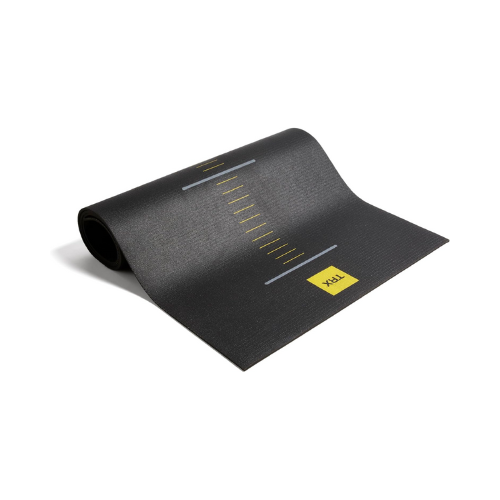
BEST FOR TRX
Training Suspension Training Mat
Buy Now On Amazon
Buy at trx training
If you’re into suspension training, this TRX Training Mat is a handy and versatile option. Marked with graduated line measurements, it’s designed to help make you aware of your angles and adjust as needed while bodyweight training. The 5-millimeter, high-traction PVC mat offers a firm and durable foundation for a variety of exercises — features that Coronel, a master TRX instructor, says are essential in every proper exercise mat.
Whether you’re using your TRX straps, slam balls, kettlebells, or medicine balls, this spacious 24 by 72-inch mat gives you room to move and can take a proper pounding. It retails for $70 and comes with a 6-year warranty, as well as a free trial of the TRX Training Club app, which features hundreds of unlimited, on-demand workouts.
Also consider: One of Coronel’s favorite mats, this 5-millimeter Naboso Training Mat is a joint-friendly mat designed for barefoot workouts thanks to its high grip and ample cushion.
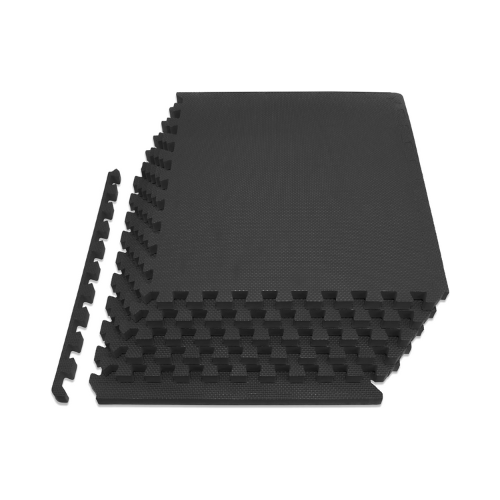
BEST CUSTOMIZABLE
ProsourceFit Extra Thick Puzzle Exercise Mat
Buy Now On Amazon
Looking to customize the size of your mat — or better yet, fully equip your personal gym with matted flooring? Look no further than these mat tiles by ProsourceFit. By using these tiles, you can transform as much of a room, garage, or outdoor space into a studio with ¾-inch or 1-inch cushioned flooring.
This mat option is also easy to install and tailor to the dimensions of any room. Made from water-resistant EVA foam, these tiles lock into place to shield flooring and protect joints from impact and equipment.
Not only is it a clever exercise option, it’s also budget-conscious, too. Snag as many 6-, 18-, or 24-packs of tiles for $50 to $129 a set.
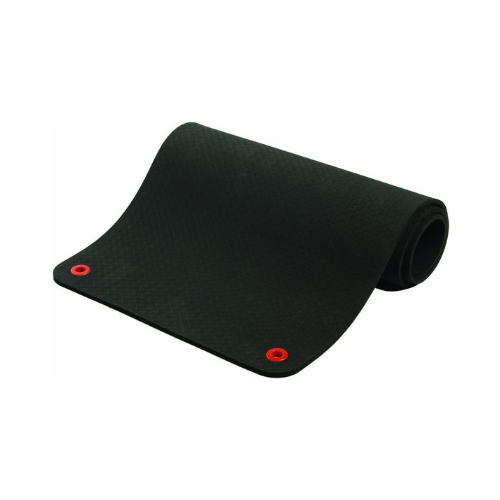
MOST VERSATILE
SPRI Hanging Exercise Mat
Buy Now On Amazon
Buy at get actv
Buy at fitness 1st
For small homes or workout areas, compact storage is always a bonus with exercise equipment. Thankfully, SPRI was way ahead of the game with their Hanging Exercise Mat, which features a built-in storage solution: two rust-proof grommets on one end for hanging on your wall.
This space-savvy, closed-cell mat is made from dense, commercial-grade foam and comes in two different sizes (a smaller 56 by 23-inch and a standard 71 by 23-inch) and thicknesses, (9.5- or 15.9-millimeters). Unlike other thick foam mats, SPRI’s mat lies nice and flat, providing a stable surface for restorative yoga, pilates, strength training, HIIT, and more — just how Coronel likes his exercise mats.
Depending on the size, this versatile, heavy-duty mat retails for $70 — a worthwhile price to pay when saving on space.
Frequently Asked Questions About Exercise Mats
Is There a Difference Between a Yoga Mat and an Exercise Mat?
While many mats on the market can be used for both yoga and general exercise purposes, there are some differences between the two that are worth noting, say Duran and Coronel. Whichever you choose ultimately depends on your needs, preferences, and the types of activities you’ll be using the mat for.
A yoga mat is typically thinner and more lightweight, with a textured or sticky surface to provide grip for holding yoga poses and maintaining balance. Yoga mats prioritize stability and traction, as yoga poses often involve holding static positions for extended periods. “For yoga, you want something that doesn’t ‘give’ that much when you’re on your feet, especially if you’re doing balanced-based stuff,” says Duran.
An exercise mat can vary in thickness, grip, and size than a standard yoga mat. They might be thicker and more cushioned, offering support and comfortable cushioning that protects the joints during a variety of exercises, including stretching, pilates, core workouts, or high-impact exercises. Other exercise mats might be thinner, firmer, and grippier to serve as a durable platform with extra stability during dynamic movements or lifts.
Do I Really Need This Thing? Will Using an Exercise Mat Make Me Look Weak?
SPY’s experts say that using an exercise mat for workouts isn’t a necessity, but it can definitely make your session safer and more comfortable, particularly during floor exercises or yoga where cushioning and grip are beneficial. Exercise mats also provide stability and support, helping to prevent injuries and allowing for better concentration on form and technique, irrespective of one’s fitness level or strength. So despite what the haters think, using a mat doesn’t mean you’re a wuss. Rather, it demonstrates a preparedness for workouts and a focus on maximizing effectiveness and prioritizing safety during workouts.
If you decide to invest in an exercise mat in your routine, Coronel says that the most important thing is to actually use it. “It’s like any other tool,” he says. “If you don’t use it, it’ll just look cool in your car in the corner [of your room].”
Are There Any Exercise Mats That I Definitely Shouldn’t Buy?
When shopping for your exercise mat, it’s wise to avoid those with poor-quality materials or construction that may compromise durability and performance. Mats that are excessively thin may not provide adequate cushioning, traction, or support, while mats with a strong chemical odor could indicate the presence of harmful or irritating materials to those with rubber or latex allergies. Mats that are too large or too small for your body or workout space may not be practical, safe, or comfortable, either.
What’s the Best Way to Keep My Exercise Mat From Getting Nasty?
To keep your exercise mat from getting ripe, Cornel recommends regular post-session cleaning. “Clean your mat every day and then roll it up after it dries,” he says. “Don’t roll that sucker up when it’s wet.” Use a clean towel to wipe it down to remove sweat, dirt, and bacteria, and always follow the manufacturer’s instructions so you don’t compromise your mat’s materials with harsh cleansers. Duran recommends using warm water and a gentle soap, which you can easily DIY.
Aim to deep clean your exercise mat regularly with a mild, but effective solution of equal parts water and white vinegar, or store-bought mat cleaner, using a soft cloth or sponge to gently scrub its surface. Always let your mat air dry thoroughly before storing. According to SPY’s experts, you might even consider using a towel, yoga mat towel, or socks during your workouts to minimize direct contact between your body, sweat, or bacteria, and the mat’s surface.
Proceed to Checkout
More Top Deals from SPY
Best of SPY
